![]()
Budget 2004 - Budget Plan
- Table of Contents - Previous
- Next -
Chapter 2
Economic Developments and Prospects
Highlights
- During 2003 economic activity in Canada slowed because of a series of unforeseen shocks. As a result, real gross domestic product (GDP) expanded only 1.7 per cent for the year, well below the 3.2 per cent expected by private sector economists at the time of the 2003 budget.
- Severe acute respiratory syndrome (SARS), bovine spongiform encephalopathy (BSE), the blackout in Ontario and the rapid appreciation of the Canadian dollar took their toll on the Canadian economy, with exports falling 2.1 per cent relative to their levels in 2002.
- Nevertheless, strength in domestic demand through most of the year, supported by low interest rates, helped offset the weakness in exports.
- Canada’s labour market strengthened in the latter part of 2003. Since December 2002 the economy has created 271,900 new jobs, all full-time.
- Looking ahead, solid domestic fundamentals, low interest rates and a more favourable global economic environment, particularly a stronger U.S. economy, are expected to support Canadian growth. Private sector economists expect real GDP growth in Canada to average 2.7 per cent in 2004, significantly better than last year but still well below the 3.5 per cent expected at the time of the 2003 budget. Private sector economists expect growth of 3.3 per cent in 2005.
- Although the economy is expected to strengthen in 2004 and 2005, the level of economic activity will fall short of that expected at the time of the 2003 budget. Private sector forecasters now forecast the level of real GDP to be about $25 billion less through 2005 than what they anticipated at the time of the 2003 budget.
- There are two main risks to the Canadian economic outlook. The first is the uncertainty regarding the impact on the economy of the unprecedented appreciation of the Canadian dollar. The second is the sustainability of the U.S. economic recovery.
Introduction
This chapter reviews recent economic developments and prospects. Using the average of private sector economic forecasts, it establishes the economic planning assumptions that underlie the Government’s budget plan and presents an assessment of risks and uncertainties associated with the economic outlook.
Canada was hit by a series of significant shocks last year, ranging from the outbreak of SARS and a major power blackout in Ontario to forest fires in British Columbia, a hurricane in Atlantic Canada and a case of BSE in the Prairies.
At the same time, the Canadian dollar soared by more than 20 per cent against the U.S. dollar. This rise was mainly the result of sustained weakness in the American currency, which fell against all other major currencies. The rising Canadian dollar contributed to a decline in the volume of Canada’s exports and an increase in imports during most of 2003.
These developments cut heavily into Canada’s growth rate last year. However, solid domestic fundamentals, low interest rates and a more favourable global economic environment should support growth going forward. And although private sector economists expect stronger growth this year and next, they do not expect the economy to regain the economic ground lost since the 2003 budget over this period.
Economic Developments and Prospects
2003 was a difficult year for the Canadian economy
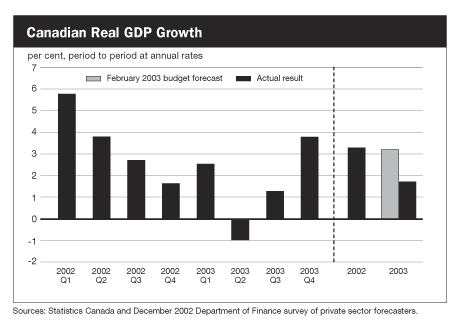
- During 2003 Canadian economic growth slowed because of a series of shocks including the SARS outbreak, the mid-August power blackout in Ontario, the discovery of a case of BSE in Alberta, forest fires in British Columbia, a hurricane in Atlantic Canada, and a more than 20-per-cent appreciation of the Canadian dollar.
- After first-quarter growth of 2.5 per cent, the Canadian economy contracted 1.0 per cent in the April-to-June period—only the second quarter of negative growth since 1992. Growth resumed in the third quarter at a weak 1.3 per cent followed by a stronger 3.8 per cent in the fourth quarter.
- The Canadian economy expanded 1.7 per cent in 2003 as a whole, roughly half the rate expected at the time of the 2003 budget.
Economic growth in 2003 slowed because of a series of shocks …

- The shocks Canada experienced last year affected output in a broad range of sectors. With the appearance of SARS during the spring of 2003, travel-related industries, including air transportation and accommodation services, suffered sharply reduced activity.
- The U.S. ban on imports of Canadian beef, imposed when a case of BSE was discovered, led to a sharp drop in the output of the animal slaughtering and meat processing industries between April and June. Forest fires struck British Columbia during the summer and affected the lumber industry in the interior of the province.
- In August the electricity blackout in Ontario crippled much of the province’s manufacturing sector for several days and reduced the output of public administration.
… including a rapid and sizeable appreciation of the Canadian dollar, reflecting a realignment of world currencies
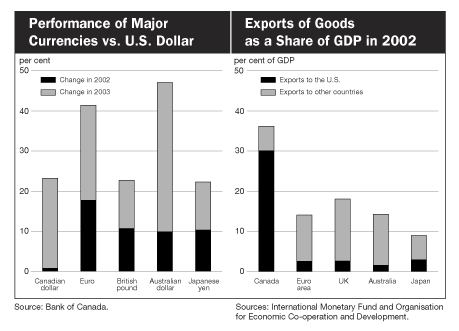
- Over the course of 2003 the Canadian dollar appreciated more than 20 per cent against its U.S. counterpart, returning to levels last reached in late 1993. The rise of the Canadian dollar reflected in part a general weakness of the U.S. dollar against all major currencies.
- While some of these currencies have appreciated more than the Canadian dollar over the past two years, on a trade-weighted basis the Canadian dollar has appreciated as much or more than other major currencies. Since Canada exports a larger share of its GDP to the U.S. than any other country, the depreciation of the U.S. dollar has been a more significant economic development for Canada than for other major economies.
|
The Effects of an Appreciation of the Canadian Dollar on the Economy
|
In general, a significant increase in the value of the Canadian dollar reduces the profits of exporters and lowers foreign demand for Canadian goods and services. To the extent that the exchange rate appreciation also results in lower import prices in Canada, Canadian businesses and consumers tend to substitute cheaper imported goods for domestic products. This reduces the revenues of domestic producers who compete with foreign companies in the Canadian market. As foreign and domestic demand for Canadian goods and services falls, output and ultimately employment can be negatively affected in some industries.
On the other hand, a stronger Canadian dollar also leads to lower costs for imported materials, parts, and machinery and equipment, helping to mitigate the negative impact on profits and encouraging investment, which in turn should enhance productivity. In addition, importers of goods—such as those in the wholesale and retail industries—may see their sales increase because of a rise in the Canadian dollar.
Further, the impact of a stronger Canadian dollar on the profits of exporters can be offset, to some degree, if there is more robust demand abroad and higher commodity prices.
Economic shocks, as well as a hesitant U.S. recovery early in the year, took their toll on Canadian exports in 2003
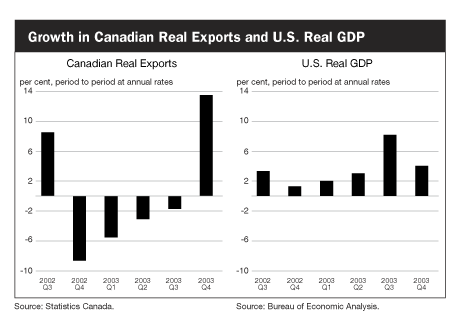
- The appreciation of the Canadian dollar in the first part of 2003 exacerbated an already difficult situation for Canadian exporters. They had been facing relatively weak and uneven external demand since the 2001 global slowdown, particularly from a sluggish U.S. economy, as well as from domestic shocks early in the year.
- In the second half of 2003 the external environment improved considerably. The U.S. economy grew an exceptional 8.2 per cent in the third quarter, led by surging sales of durable goods and investment in equipment and software. Growth continued at a robust 4.1-per-cent pace in the fourth quarter.
- While a reinvigorated U.S. economy generally implies increased demand for Canadian exports, they were negatively affected by the appreciation of the Canadian dollar. Exports fell during most of 2003 and, despite a sharp rebound in the fourth quarter, they remained below their average level of the previous year.
The Bank of Canada responded to economic shocks by lowering interest rates

- In the early part of 2003 upward pressure on prices and concerns about rising inflation expectations prompted the Bank of Canada to raise its key policy rate by a total of 50 basis points to 3.25 per cent.
- However, reduced pressure on prices as well as increased economic slack in the wake of SARS, BSE and the rapid appreciation of the Canadian dollar led the Bank to lower its key policy rate in July and again in September, back to 2.75 per cent.
- In January 2004 the Bank lowered the policy rate to 2.5 per cent, noting that despite strong global economic growth, the rapid appreciation of the Canadian dollar had cut into the overall growth of aggregate demand for Canadian goods and services through weaker exports and increased imports. The Bank again lowered the rate to 2.25 per cent on March 2, explaining that while external demand was slightly stronger than expected, final domestic demand in Canada was slightly weaker.
Strength in domestic demand helped to offset shocks in 2003
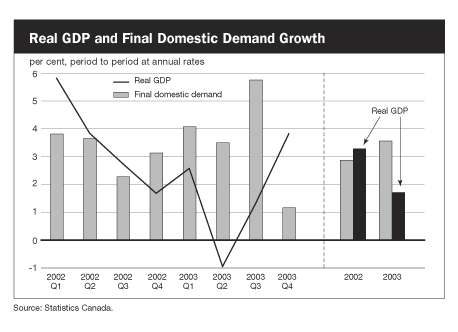
- While a series of shocks slowed real GDP growth in Canada over the course of 2003, growth in final domestic demand, particularly consumer spending, remained robust over much of last year thanks to low interest rates and solid consumer and business confidence.
- Although final domestic demand growth weakened in the fourth quarter, these factors should support consumer and business spending going forward.
Consumer spending contributed significantly to growth in 2003 …
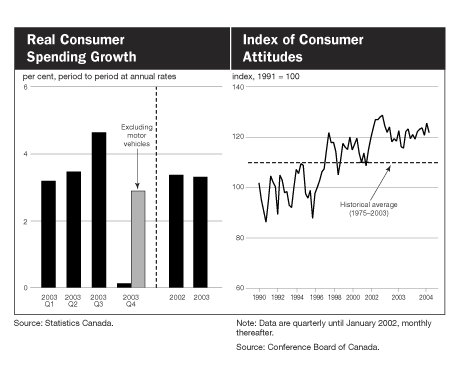
- Consumer spending helped to support the Canadian economy during most of 2003. For the year as a whole, consumer spending grew 3.3 per cent. In particular, the booming housing market generated strong growth in purchases of furniture and appliances. Growth in consumer spending stalled in the fourth quarter of last year, mainly reflecting a sharp decline in sales of motor vehicles and parts. In fact, excluding sales of motor vehicles and parts, consumer spending increased 2.9 per cent in the fourth quarter.
- Consumer confidence remains at historically high levels which, along with low interest rates, rising incomes and good labour market prospects, should support consumer demand.
… along with a strong housing market
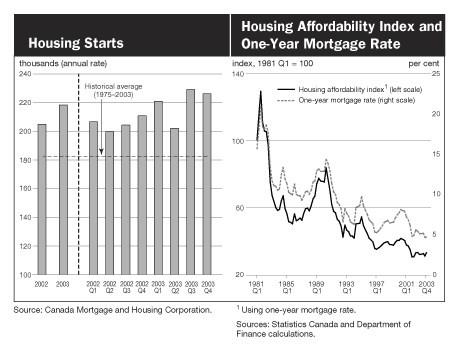
- The strength of residential investment has been an important contributor to economic growth in Canada over the past two years. Employment growth, rising incomes and favourable mortgage rates have improved affordability, encouraging consumers to purchase houses.
- By the end of December 2003, households were saving more than $2,100 on a one-year mortgage of $100,000 compared to what they would have paid at the beginning of 2001.
- To meet growing demand, housing starts have exceeded the 200,000 mark in each of the last six quarters—well above their historical average.
Household net worth is at historically high levels
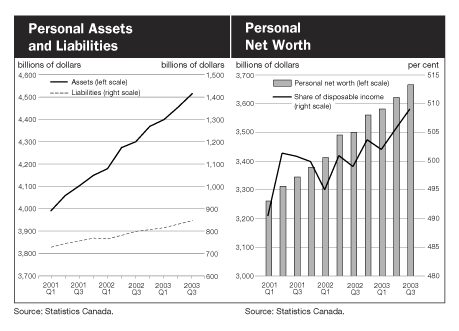
- Spending by consumers, notably on housing and associated durable goods, was the key ingredient of strong domestic demand growth during 2003. While increased spending by consumers raised the level of household debt during the year, the value of household assets, particularly housing, rose even more rapidly. As a result, personal net worth increased steadily during the year. By the end of the third quarter of 2003, total household assets stood at $4.5 trillion, more than five times the value of household debt.
- Rising personal net worth, along with low financing costs, should support consumer spending in the months ahead.
Rising commodity prices have supported Canadian incomes and profits
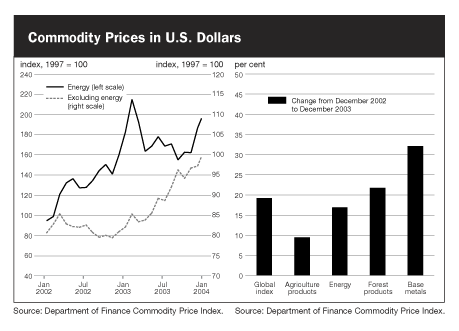
- Prices of Canadian commodities have soared over the past two years, reflecting a stronger world economy and robust growth in international demand for raw materials. During 2003 commodity prices measured in U.S. dollars increased 19.1 per cent, with non-energy commodities leading the gains. In particular, prices of base metals rose 32 per cent.
- Higher commodity prices have had positive impacts on Canadian incomes and profits.
Low borrowing costs, healthy profits and strong business confidence …

- Despite the stronger Canadian dollar, corporate profits as a share of GDP in Canada remained above their historical average during 2003, thanks in part to low borrowing costs and rising commodity prices.
- As well, the Conference Board of Canada reports that business confidence for the fourth quarter of 2003 reached its highest level since the third quarter of 2000. In particular, an increasing proportion of firms believe that economic conditions will improve in the next six months, and more than half of the firms surveyed believe that now is a good time to invest.
… supported business investment in 2003
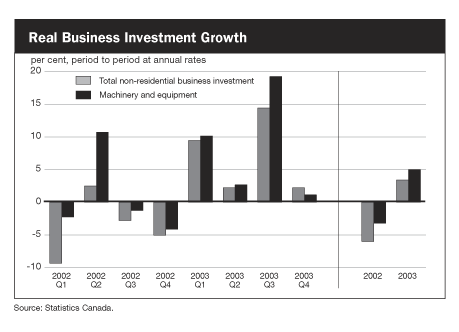
- Although the quarterly pattern was uneven, on average, non-residential business investment in 2003 was 3.4 per cent higher than its level in 2002, led by a 5-per-cent jump in investment in machinery and equipment. In particular, investment in information and communications technology goods showed a marked improvement in the second half of the year.
- The combination of healthy corporate profits, low borrowing costs, rising commodity prices and increased business confidence bodes well for investment.
Canada’s current account remains in surplus while the U.S. current account deficit remains large

- Canada’s real trade balance has been negatively affected by the significant appreciation of the Canadian dollar, domestic economic shocks and a sluggish world recovery.
- However, the current account has remained in surplus, supported by favourable movements in the terms of trade (price of exports relative to imports).
- Canada’s current account has now been in surplus for 18 consecutive quarters, averaging over 2 per cent of GDP. The string of current account surpluses pushed Canada’s net foreign debt-to-GDP ratio down to 18.4 per cent by the third quarter of 2003, close to its lowest level in almost 50 years. The net foreign debt-to-GDP ratio increased slightly in 2003 due to the appreciation of the Canadian dollar.
- These developments stand in sharp contrast to the U.S., where large current account deficits have raised the stock of net foreign debt to over 22 per cent of GDP. Indeed, the current weakness in the U.S. dollar is likely a corrective response to the deteriorating current account balance.
Strong employment growth has helped to reduce the unemployment rate
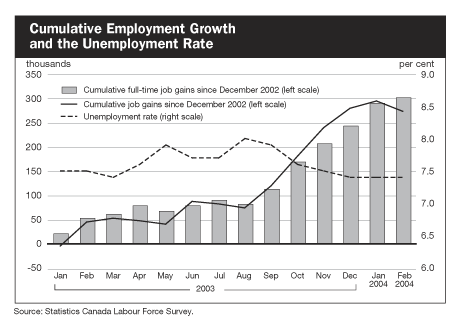
- After net growth of only 73,100 between December 2002 and August 2003 reflecting the negative impact of the 2003 shocks on the Canadian economy, employment increased 205,100 during the last four months of 2003. This brought job gains during 2003 to 278,200.
- Modest employment gains in January 2004 were offset by a decline in employment in February, driven by a reduction in part-time positions. However, the economy created 58,200 new full-time positions during the first two months of 2004. Indeed, since December 2002, all of the jobs created have been full-time positions. Employment growth in the service sector was particularly strong, with nearly 300,000 jobs gained between December 2002 and February 2004. However, economic shocks and the stronger Canadian dollar took their toll on the manufacturing sector, where 62,700 jobs were lost over the same period.
- Strong employment growth during the last months of 2003 reduced the unemployment rate to 7.4 per cent by December 2003, after it had drifted up to 8 per cent by August 2003. The unemployment rate has now returned to the level recorded at the beginning of 2003, before the various shocks hit the economy.
Employment and participation rates are at record highs, indicating continued confidence in labour market prospects
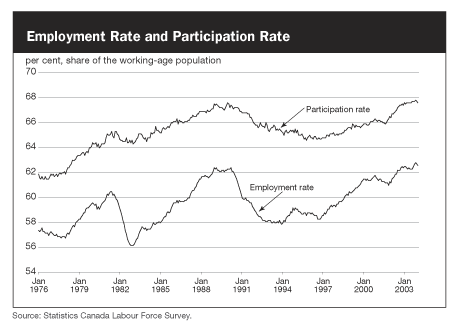
- Canada’s participation rate—the share of the working-age population that is either working or actively looking for work—increased steadily during 2003 and reached a record high in December 2003 (67.7 per cent) before edging back to 67.5 per cent in February 2004. The high participation rate indicates that Canadians are confident about their labour market prospects.
- Along with higher rates of participation in the labour market, the share of the working-age population with a job—or the employment rate—stood at 62.5 per cent in February 2004, just below its highest level on record reached in December 2003 (62.7 per cent).
Private Sector Economic Forecasts
The Department of Finance surveys about 20 private sector economic forecasters on a quarterly basis regarding their outlook for the Canadian economy. The Department also regularly reviews forecasts for the U.S. and major overseas economies from U.S. private sector forecasters and international organizations such as the Organisation for Economic Co-operation and Development (OECD) and the International Monetary Fund.
Department officials also meet with a group of private sector economists to discuss Canada’s economic outlook and the risks and uncertainties associated with the outlook. The Department’s survey of private sector forecasters is the basis for the economic assumptions that underlie the fiscal projections for the budget.
The economic forecasts reported here reflect the survey of private sector forecasters conducted by the Department following the release of the fourth-quarter National Accounts by Statistics Canada on February 27, and the most recent forecasts by private sector economists in the U.S. and by the OECD.
The U.S. economy is expected to grow at a stronger pace in 2004
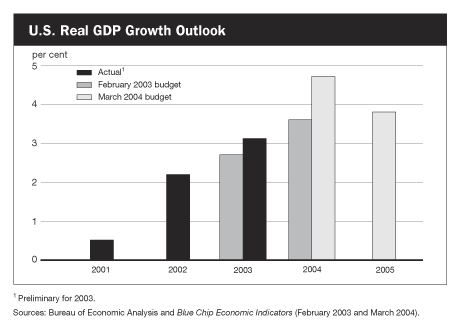
- Following the U.S. recession in 2001, U.S. real GDP growth was relatively slow and uneven in 2002. This reflected geopolitical uncertainties, accounting scandals and the lingering effects of the bursting of the stock market bubble.
- In 2003 fiscal stimulus, low interest rates and a depreciating American dollar contributed to a significant strengthening of the U.S. recovery. In the third quarter U.S. GDP jumped 8.2 per cent, the strongest quarterly growth rate in nearly 20 years. The American economy grew another 4.1 per cent in the fourth quarter, bringing full year growth for 2003 to 3.1 per cent—the strongest annual growth rate since 2000.
- Consumer spending, business investment in equipment and software and exports are expected to support strong growth in the U.S. economy again in 2004. Private sector forecasters expect growth to average 4.7 per cent this year and 3.8 per cent in 2005.
- A stronger U.S. economy will to some degree offset the impact of the appreciation of the Canadian dollar on Canadian exporters.
The upswing in the U.S. economy has coincided with an improved outlook for Europe and Japan as well

- The upswing in the U.S. economy has coincided with modest improvements in the outlook for Europe and Japan.
- After months of near stagnation, growth in the major euro area economies is expected to strengthen in 2004 and further improve in 2005. According to the OECD, the improved outlook for the euro area over the next two years is underpinned by strengthening world trade, improving corporate balance sheets and supportive monetary policy. UK growth is also expected to remain strong over the next two years.
- As well, growth has recently accelerated in Japan after two years of weakness, supported in part by fast-growing markets in neighbouring Asian economies, particularly China, where real GDP surged 9.1 per cent in 2003 and is expected to remain above 7 per cent in 2004 and 2005. Nevertheless, despite the recent improvement, ongoing deflation and structural problems, including banking and corporate sector weakness, are expected to constrain domestic demand and real GDP growth in Japan in 2004 and 2005.
- Overall, however, the outlook for the external environment over the next two years is one of progressive recovery.
Forecasters expect economic growth in Canada to strengthen in 2004 and 2005
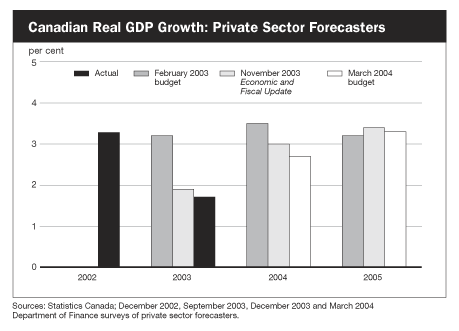
- Private sector forecasters expect slightly weaker near-term economic growth than previously anticipated, with the dampening effect of a stronger dollar offsetting the positive impact of a more robust U.S. recovery.
- Forecasters now expect the economy to grow by 2.7 per cent in 2004, down from 3 per cent in the November 2003 Economic and Fiscal Update and 3.5 per cent in the February 2003 budget. For 2005, forecasters expect growth of 3.3 per cent, virtually unchanged from the February 2003 budget.
The economic growth outlook would not be sufficient for the economy to regain the ground lost since the 2003 budget

- Although the economy is expected to strengthen in 2004 and 2005, this would not be sufficient for Canada to achieve the level of economic activity forecast at the time of the 2003 budget. In summary, growth was slower than expected in 2003; the forecast for growth in 2004 has been lowered; and growth for 2005 is only marginally higher than expectations at the time of the 2003 budget. The result is that private sector forecasters are now predicting the level of real GDP to be about $25 billion lower in each of 2004 and 2005 than what they expected at the time of the 2003 budget.
Private sector forecasters expect interest rates to remain low well into 2004
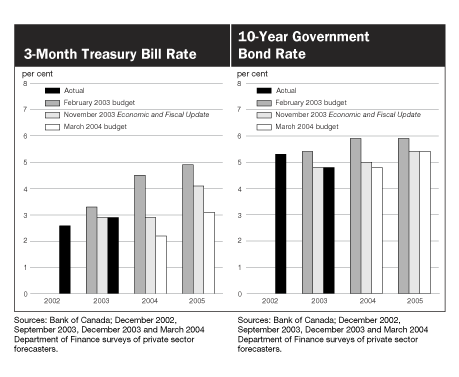
- A stronger Canadian dollar and somewhat weaker-than-expected economic growth have led private sector forecasters to lower their projections for short- and long-term interest rates. They expect short-term interest rates in 2004 and 2005 to be 70 and 100 basis points lower than forecast last November and 230 and 180 basis points lower than anticipated at the time of the February 2003 budget. Reflecting these lower expected short-term rates, they have reduced their 2004 long-term interest rate forecast to 4.8 per cent, 110 basis points lower than forecast in the 2003 budget.
- Private sector forecasters have left their GDP inflation forecast roughly unchanged since the November Update. They have assumed that the impact of weaker growth and a stronger dollar on domestic prices will be offset by the impact of stronger commodity prices on export prices.
- Private sector forecasters project a decline in the unemployment rate from 7.6 per cent in 2003 to 7.2 per cent in 2005.
Risks and Uncertainties
There are both upside and downside risks to the Canadian outlook. There is an unusual degree of uncertainty regarding the impact of a stronger dollar on the economy given the size and rapidity of the appreciation over the last year.
The U.S. recovery also poses upside and downside risks to the Canadian outlook. On the downside, the most significant risk is continued labour market weakness in the U.S. Despite modest gains in payroll employment in recent months, the U.S. employment recovery so far has been the slowest of all cycles over the past 60 years. Without greater job creation, household spending might slow, which could dampen the momentum from fiscal stimulus and affect consumer confidence.
However, on the upside, the recent strength in U.S. productivity growth is supporting incomes and translating into stronger corporate profits. Improved corporate balance sheets, together with low interest rates and improved business confidence, bode well for investment and hiring in the coming months.
In the medium term, the main risk is the growing U.S. budget deficit, which could put upward pressure on interest rates, crowd out investment and dampen growth if not corrected. This would in turn negatively affect the Canadian outlook.
Overall, with Canada’s strong monetary and fiscal fundamentals, the Canadian economy is well positioned to deal with these risks.
Evolution of Private Sector Forecasts for 2003 to 2005
|
|
|||
| 2003 | 2004 | 2005 | |
|---|---|---|---|
|
|
|||
| (per cent) | |||
| Real GDP growth | |||
| February 2003 budget | 3.2 | 3.5 | 3.2 |
| November 2003 Economic and Fiscal Update | 1.9 | 3.0 | 3.4 |
| March 2004 budget | 1.7 | 2.7 | 3.3 |
| GDP inflation | |||
| February 2003 budget | 2.2 | 1.9 | 1.7 |
| November 2003 Economic and Fiscal Update | 3.3 | 1.4 | 1.9 |
| March 2004 budget | 3.4 | 1.4 | 1.7 |
| Nominal GDP growth | |||
| February 2003 budget | 5.4 | 5.4 | 5.0 |
| November 2003 Economic and Fiscal Update | 5.3 | 4.4 | 5.3 |
| March 2004 budget | 5.2 | 4.1 | 5.1 |
| 3-month Treasury bill rate | |||
| February 2003 budget | 3.3 | 4.5 | 4.9 |
| November 2003 Economic and Fiscal Update | 2.9 | 2.9 | 4.1 |
| March 2004 budget | 2.9 | 2.2 | 3.1 |
| 10-year government bond rate | |||
| February 2003 budget | 5.4 | 5.9 | 5.9 |
| November 2003 Economic and Fiscal Update | 4.8 | 5.0 | 5.4 |
| March 2004 budget | 4.8 | 4.8 | 5.4 |
| Unemployment rate | |||
| February 2003 budget | 7.3 | 7.0 | 6.7 |
| November 2003 Economic and Fiscal Update | 7.7 | 7.7 | 7.4 |
| March 2004 budget | 7.6 | 7.5 | 7.2 |
| Employment growth | |||
| February 2003 budget | 2.1 | 1.8 | 1.5 |
| November 2003 Economic and Fiscal Update | 1.9 | 1.3 | 1.7 |
| March 2004 budget | 2.1 | 1.6 | 1.5 |
| Addendum: | |||
| U.S. real GDP growth | |||
| February 2003 budget | 2.7 | 3.6 | n/a |
| November 2003 Economic and Fiscal Update | 2.7 | 3.9 | n/a |
| March 2004 budget | 3.1 | 4.7 | 3.8 |
|
|
|||
| Sources: December 2002, September 2003, December 2003 and March 2004 Department of Finance surveys of private sector forecasters, and February 2003, October 2003 and March 2004 Blue Chip Economic Indicators. | |||
Note: This chapter incorporates data available up to March 12, 2004. Figures in this chapter are at annual rates unless otherwise noted.
- Table of Contents - Previous - Next.
|
|
|||||
| Last Updated: 2004-03-23 | |||||